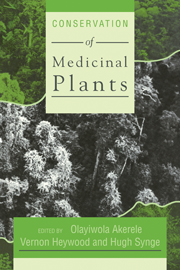Book contents
- Frontmatter
- Contents
- Contributors
- Preface
- Acknowledgements
- The Chiang Mai Declaration
- Introduction
- The Issue of Medicinal Plants
- Science, Industry and Medicinal Plants
- Techniques to Conserve Medicinal Plants
- Policies to Conserve Medicinal Plants
- 15 Policies and Organisation for Medicinal Plant Conservation in Sri Lanka
- 16 Experience in the Conservation of Medicinal Plants in Sri Lanka
- 17 The Conservation of Medicinal Plants Used in Primary Health Care in Thailand
- 18 Medicinal Plants and the Law
- 19 Let's Stop Talking to Ourselves: The Need for Public Awareness
- 20 Germplasm, Genetic Erosion and the Conservation of Indonesian Medicinal Plants
- Experiences from Programmes to Conserve Medicinal Plants
18 - Medicinal Plants and the Law
Published online by Cambridge University Press: 07 September 2010
- Frontmatter
- Contents
- Contributors
- Preface
- Acknowledgements
- The Chiang Mai Declaration
- Introduction
- The Issue of Medicinal Plants
- Science, Industry and Medicinal Plants
- Techniques to Conserve Medicinal Plants
- Policies to Conserve Medicinal Plants
- 15 Policies and Organisation for Medicinal Plant Conservation in Sri Lanka
- 16 Experience in the Conservation of Medicinal Plants in Sri Lanka
- 17 The Conservation of Medicinal Plants Used in Primary Health Care in Thailand
- 18 Medicinal Plants and the Law
- 19 Let's Stop Talking to Ourselves: The Need for Public Awareness
- 20 Germplasm, Genetic Erosion and the Conservation of Indonesian Medicinal Plants
- Experiences from Programmes to Conserve Medicinal Plants
Summary
Introduction
Medicinal plants, as many other products of nature, have been collected from time immemorial by traditional communities all over the world. Natural resources were considered to be the common or collective property of the group. Collection was regulated by unwritten rules based on tradition and often on religion. Stiff penalties could usually be imposed when the rules were broken. As traditional societies were often strongly territorial, wild plants and animals were protected from harvesting by outsiders by well-defined boundaries that members of other groups were not allowed to cross.
These traditional closed systems have now almost completely disappeared. A few, however, still seem to survive. In some districts of the Indian Himalayas, the collection of certain plants continues to be restricted to certain days of the year, during religious festivals (Gadgil, 1985).
The opening-up of many traditional systems brought about profound changes in the legal status of wild animals and plants. Animals became res nullius, that is to say things which cannot be the subject of ownership, even by the owner of the land on which they occur. Ownership may, however, be obtained by “occupancy”, in other words by actually killing or capturing the animal. This concept inherited from ancient roman law is now embodied, with some variations, in the legislation of a very large number of countries. A few, however, have recently enacted laws conferring on wild animals the status of public property. Whether this new status will result in more effective conservation remains to be seen.
Wild plants, on the other hand, being attached to the land, are immovables and the property of the landowner.
- Type
- Chapter
- Information
- Conservation of Medicinal Plants , pp. 259 - 272Publisher: Cambridge University PressPrint publication year: 1991
- 1
- Cited by



